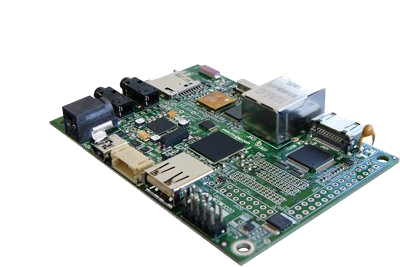Difference between revisions of "What can I do with IGEPv2"
From IGEP - ISEE Wiki
(→How to use serial console) |
(→How to use UART1 (RS232)) |
||
| Line 51: | Line 51: | ||
== How to use UART1 (RS232) == | == How to use UART1 (RS232) == | ||
| + | To test UARTs we use UART1 (dev/ttyO0) and UART3 (dev/ttyO2) via J960 connector using RS232 standard. | ||
| + | *UART1 can used by RS485 driver, we need to disable it, edit igep.ini file: <br> | ||
| + | <pre>board.ei485= yes</pre> | ||
| + | *UART1 is configured in RS232 driver, when igep line is replaced by (or type in -Maybe you don't found this line-):<br> | ||
| + | <pre>board.ei485= no</pre> | ||
| + | *By default, UART3 is used by Kernel serial console, we need to disable it, go to igep.ini file, comment next line: <br> | ||
| + | <pre>;console=ttyO2,115200n8 | ||
| + | ;console=ttyO</pre> | ||
Revision as of 13:20, 5 September 2012
|
|
Contents
- 1 Overview
- 2 What can I do
- 2.1 How to use serial console
- 2.2 Handle the GPIO-LEDS
- 2.3 How to use UART1 (RS232)
- 2.4 How to use RS-485
- 2.5 Get sound in (audio in)
- 2.6 Get sound out (audio out)
- 2.7 How to change the monitor resolution
- 2.8 How to use wifi
- 2.9 How to use bluetooth
- 2.10 How to test 3D acceleration
- 2.11 How to use the SD card
- 2.12 How to use the USB OTG
- 2.13 How to use the USB HOST
Overview
This is the 2/3 chapter of the Getting Started with IGEPv2 Tutorial Guide.
In this second chapter, we will learn some basics tasks. Upon completion, you will be ready to continue with chapter 3/3 that explains more advanced tasks.
What can I do
You must logged in the board.
How to use serial console
Connect a serial (COM port) cable (known as the AT/Everex Cable) to the 10-pin header J960 on the board. Now you need a Null-Modem DB9 male-make serial cable. Connect the cable between the board and your PC. Open the serial on your PC using your preferred serial communications program (minicom) and configure the port as follows:
- 115200
- 8N1
- no flow control (either software or hardware)
Open the serial port and the debug shell prompt should appear.
A detailed guide on how to connect via serial debug port can be found by following this link: Using serial debug port to communicate
Handle the GPIO-LEDS
The board has two user bicolor (green/red) leds available that can be controlled. In its simplest form, you can control of LEDs from userspace. LEDs appear in /sys/class/leds/ and you can turn on and off with following commands:
$ echo 0 > /sys/class/leds/d240\:green/brightness
$ echo 1 > /sys/class/leds/d240\:red/brightness $ echo 0 > /sys/class/leds/d240\:red/brightness
$ echo 1 > /sys/class/leds/d440\:green/brightness $ echo 1 > /sys/class/leds/d440\:red/brightness
A detailed guide on how use GPIO-LEDS can be found by following this link: How to handle the gpio-LED
How to use UART1 (RS232)
To test UARTs we use UART1 (dev/ttyO0) and UART3 (dev/ttyO2) via J960 connector using RS232 standard.
- UART1 can used by RS485 driver, we need to disable it, edit igep.ini file:
board.ei485= yes
- UART1 is configured in RS232 driver, when igep line is replaced by (or type in -Maybe you don't found this line-):
board.ei485= no
- By default, UART3 is used by Kernel serial console, we need to disable it, go to igep.ini file, comment next line:
;console=ttyO2,115200n8 ;console=ttyO
A detailed guide on how use UARTS can be found by following this link: How to use UARTs
How to use RS-485
This How-To is meant to be a starting point for people to learn to use RS-485 port on IGEP devices as quickly and easily as possible. We use IGEP YOCTO Firmware and RS485 example which describe how to setup and write data on the RS-485 port.
A detailed guide on how use UARTS can be found by following this link: How to use RS485
Get sound in (audio in)
External Audio input devices, such as a powered microphone or the audio output of a PC or MP3 player, can be connected to the via a 3.5mm jack (Audio IN).
You can record audio in with the application arecord, for example:
$ arecord -t wav -c 2 -r 44100 -f S16_LE -v audio-in.wav
Following output is expected on console:
Recording WAVE 'audio-in.wav' : Signed 16 bit Little Endian, Rate 44100 Hz, Stereo Plug PCM: Hardware PCM card 0 'TWL4030' device 0 subdevice 0 Its setup is: stream : CAPTURE access : RW_INTERLEAVED format : S16_LE subformat : STD channels : 2 rate : 44100 exact rate : 44100 (44100/1) msbits : 16 buffer_size : 32768 period_size : 2048 period_time : 46439 tick_time : 7812 tstamp_mode : NONE period_step : 1 sleep_min : 0 avail_min : 2048 xfer_align : 2048 start_threshold : 1 stop_threshold : 32768 silence_threshold: 0 silence_size : 0 boundary : 1073741824
When ever you think you want to stop recording just press CTRL+C
Get sound out (audio out)
Connect an external output audio device to the 3.5mm jack Audio Out connector in the board, such as external stereo powered speakers.
The amplifiers for the headset output are disabled by default, so the first thing you'll do is enable these amplifiers with:
$ amixer set -D hw:0 'Headset' 0dB $ amixer set -D hw:0 'HeadsetL Mixer AudioL2' on $ amixer set -D hw:0 'HeadsetR Mixer AudioR2' on
Then you can easily play a *.wav sound with the application Aplay, for example:
$ aplay audio-in.wav
How to change the monitor resolution
How to use wifi
How to use bluetooth
How to test 3D acceleration
How to use the SD card
How to use the USB OTG
How to use the USB HOST
You have successfully completed this chapter of the guide.
|

|
If you have any question, don't ask to ask at the IGEP Community Forum or the IGEP Community Chat | 
|



